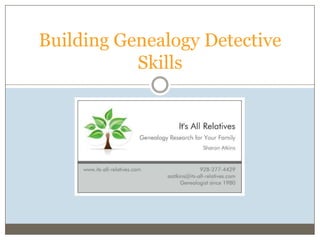
Building genealogy detective skills
- 2. Key to Being a Genealogy Detective Process Persistence Patience
- 3. Typical Genealogy Research Process Document what you know Define what you don’t know List what you want to find Create a resource list to search Collaborate with others Keep a research log
- 4. Genealogy Detective Process STEP 1: Build a timeline STEP 2: Define the specific problem STEP 3: Develop list of potential resources STEP 4: Envision a list of alternative resources STEP 5: Incorporate FAN research strategies STEP 6: Keep a research log USE A PROCESS
- 5. STEP 1: Build a Timeline Understand your ancestor in context of time and place Create a timeline Tabulate all information gathered Chronological order of life events Include column for date, age of ancestor, event and location Add local, regional, national and international historical events into the timeline
- 6. STEP 2: Define the Specific Problem Are their gaps in your ancestor’s timeline? Example Question: When/where did ancestor marry? Birth: 1829 Immigrated: 1841 Children born: 1853-1866 Clues Where did ancestor live from 1841-1853? What religion was my ancestor? His wife? Were children baptized? Where?
- 7. STEP 3: Develop List of Potential Resources List records already checked Revisit each record – how does it support the timeline facts? Seek original documents for review to validate and collect all the data New potential records to locate US Census 1790-1930 Information Table Census records variables – surname spelling, all listed with family name (step children can be “lost” this way), clues may have not been tabulated for indexing Vital records – Determine when vital records were established in your ancestor’s specific location Research Plan Records List
- 8. STEP 4: Envision List of Alternative Resources Ancestor Clues from before 1850 Seek out religious records Occupational clues may be in inventory of property taken at death Map family’s migration path and paths of others who lived in same area – understand economic causes. Waterways were method of travel – follow rivers/waterways. Recognize that geographic boundaries changed Visit or contact private university of library in the location where ancestor lived. Special collections might hold clues Fraternal and Lineage society records Reach out to other living descendants for records, files or stories.
- 9. Alternative Resources Immigration dates Expand search for passenger records for ports outside of US – Canadian ports (Halifax, North Sydney, Quebec, Saint John, Vancouver or Victoria) Not all families traveled together. Keep looking. Maiden names of women ancestors Caution: Women’s name could be listed on marriage records as her first husband’s surname, not maiden name Have a wedding photo? Research the photographer – may have lived in the community Rural area? Look at census records for neighbors – may be relations
- 10. Alternative Resources Search local school records or mortuary records Age when stopped having children may be clue to when she was born…children born to women after age 45 unusual. Divorce records May have moved to live with children when widowed If woman widowed at young age, a close male relative may have been estate administrator. Newspaper legal notices may be a source. Unusual middle names may be worth research – could be family surnames. Study naming conventions during ancestor’s time. BE PERSISTENT
- 11. STEP 5: Incorporate FAN Research Friends, Associates and Neighbors (Peripheral People) Who are the people who appear in source documents with ancestors? Witnesses, etc.? Who were people who worked in the same occupations? Who were people mentioned in same wills with ancestor? Immigrants tended to settle in groups with common origin and/or religion. Neighbors can be a clue to determining ancestor’s origin. Search for the name of other neighbors who were on another census’ page with your ancestor Was your ancestor “underage” at time of military conflict and did they register using fake name? Search all military enlistments for specific geographic area.
- 12. FAN Research Who was the community doctor? Did he keep records or a journal? Search who was religious leader and determine all the people he christened, married or buried…they may be relatives. Visit ancestor’s cemetery and note names of people buried nearby.
- 13. STEP 6: Keep a Research Log List source citations Helps to develop more relevant conclusions from data Keep track of date sources were viewed. Include successful and not successful attempts. Eliminating data is valuable and may save going down the wrong path. New data is being indexed, categorized and digitalized every day – appropriate to revisit. BE PATIENT
- 14. Tips for Detectives Make a plan “It’s not the plan itself that is important, it’s the act of creating the plan that has value.” Location, location, location Don’t overlook LOCAL history for timeline Validate that data makes sense Age at marriage, birth of child, etc. Take baby steps – break big questions into smaller parts Double check initial source data Evaluate facts based upon type of evidence
- 15. Tips for Detectives Place ancestors in context of time and place Understand difference between “search” and “research” Seeking out data vs. diligent and systematic inquiry into a problem Know how to best use search engines at each repository Think of ancestor as member of community – not just of a family.
- 16. Building Genealogy Detective Skills Process Persistence Patience